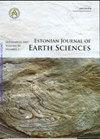波罗的海自流盆地晚更新世和全新世地下水流动史:数值模式和水文地球化学资料的综合
IF 0.8
4区 地球科学
Q4 GEOSCIENCES, MULTIDISCIPLINARY
引用次数: 0
摘要
本文基于塔林理工大学地质系及其合作伙伴在2012-2020年开展的水文地质研究,回顾了目前对波罗的海自流盆地(BAB)北部从晚更新世末到现在的地下水流动历史的认识。为了了解冰川作用与地下水流动之间的联系,将水文地球化学数据与各种数值模型相结合。我们早期的研究结果和已发表的关于巴布河地下水流动历史的文献也被考虑在内。地下水流动历史的重建是建立在地下水同位素、化学和溶解气体组成数据库的基础上的。该数据库包含1974-2017年期间收集的1155个地下水样本的数据。研究发现,巴布盆地的地下水受3种不同水团的混合控制:间冰期/现代大气水(δ18O≈-11‰)、冰川融水(δ18O≤-18‰)和更古老的同生端元(δ18O≥-4.5‰)。数值模拟表明,青藏高原北部地区融水的保存受限制层和靠近含水层露头区控制。与现代地形驱动的地下水流动条件相比,含冰川源地下水的含水层处于一种暂态状态。本文还回顾了未来研究中最重要的主题,这些主题可以解决我们当前知识中的空白。本文章由计算机程序翻译,如有差异,请以英文原文为准。
Late Pleistocene and Holocene groundwater flow history in the Baltic Artesian Basin: a synthesis of numerical models and hydrogeochemical data
We review our current understanding of groundwater flow history in the northern part of the Baltic Artesian Basin (BAB) from the end of the Late Pleistocene to current conditions based on the hydrogeological studies carried out in 2012–2020 by the Department of Geology, Tallinn University of Technology and its partners. Hydrogeochemical data and various numerical models are combined in order to understand the link between glaciations and groundwater flow. The results of our earlier research and published literature on groundwater flow history in the BAB are also taken into account. The reconstruction of groundwater flow history is based on the database of the isotopic, chemical and dissolved gas composition of groundwater. The database contains data on 1155 groundwater samples collected during 1974–2017. We find that groundwater in the BAB is controlled by the mixing of three distinct water masses: interglacial/modern meteoric water (δ18O ≈ –11‰), glacial meltwater (δ18O ≤ –18‰) and an older syngenetic endmember (δ18O ≥–4.5‰). The numerical modelling has suggested that the preservation of meltwater in the northern part of the BAB is controlled by confining layers and the proximity to the outcrop areas of aquifers. Aquifers containing groundwater of glacial origin are in a transient state with respect to modern topographicallydriven groundwater flow conditions. The most important topics for future research that can address gaps in our current knowledge are also reviewed.
求助全文
通过发布文献求助,成功后即可免费获取论文全文。
去求助
来源期刊

Estonian Journal of Earth Sciences
地学-地球科学综合
CiteScore
1.50
自引率
9.10%
发文量
11
审稿时长
>12 weeks
期刊介绍:
The Estonian Journal of Earth Sciences is an international scientific open access journal published by the Estonian Academy of Sciences in collaboration with the Tallinn University of Technology, the University of Tartu, the Estonian University of Life Sciences and the Talllinn University.
The journal publishes primary research and review papers in the English language. All articles are provided with short Estonian summaries.
All papers to be published in the journal are peer reviewed internationally.
The journal is open for publications in all fields of Earth sciences, including besides different geological sensu lato disciplines, also geography and oceanography having certain connection with our part of the world, North Europe and the Baltic area in particular.
 求助内容:
求助内容: 应助结果提醒方式:
应助结果提醒方式:


